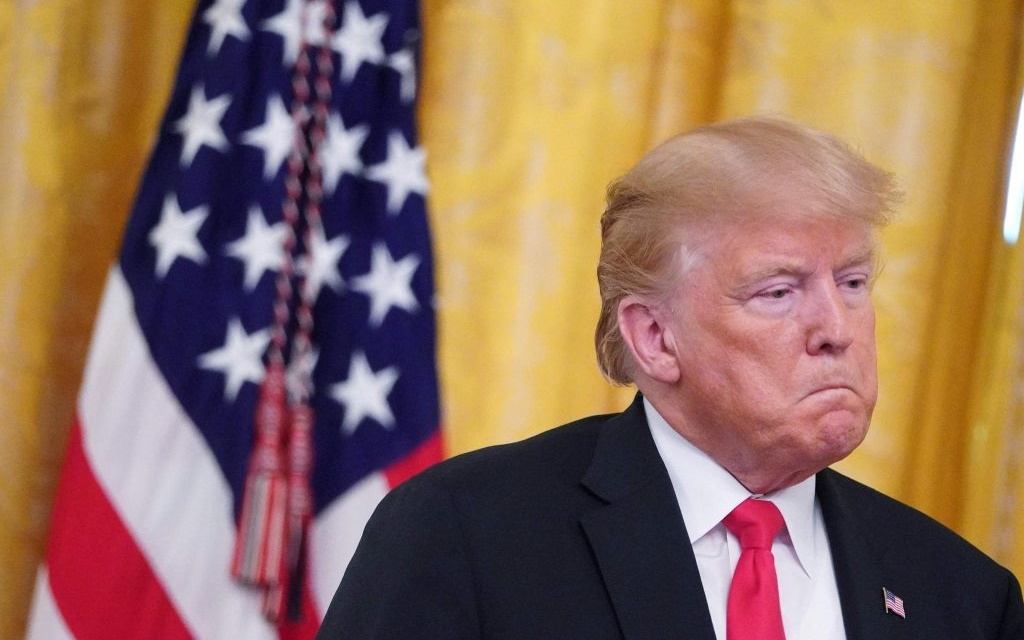Losing his temper on Twitter, Donald Trump orders more tariffs on all Chinese products and attacks the US Federal Reserve as an “enemy”.
Amid dozens of Friday messages and retweets, Trump began by pushing back signs of an economic downturn that could threaten his re-election bid:
The Economy is strong and good, whereas the rest of the world is not doing so well. Despite this the Fake News Media, together with their Partner, the Democrat Party, are working overtime to convince people that we are in, or will soon be going into, a Recession.
See TrumpWatch, Day 944: Trump Flounders Over Debt, Amid Cut in Job Gains
But he was soon angered that a speech by Federal Reserve Chairman Jerome Powell did not promise an interest rate cut — even though any reduction would come through a meeting of the Fed in Washington, not an address by its chairman to an audience in Wyoming.
Having anticipated the speech, “Now the Fed can show their stuff!”, Trump declared that Powell as well as Chinese President Xi Jinping was now an “enemy”.
….My only question is, who is our bigger enemy, Jay Powell or Chairman Xi?
— Donald J. Trump (@realDonaldTrump) August 23, 2019
Trying to stave off an economic dip, amid worries over his trade wars and an unprecedented Federal Government debt fed by his December 2017 tax, Trump has demanded that the Fed slash interest rates.
At the end of July, the national’s top bank cut the rate for the first time since 2008, lowering it 0.25% to just below 2.25%. But Powell made clear that the reduction was a “one-off” step.
See TrumpWatch, Day 923: Federal Reserve Cuts Interest Rate — But Trump Continues Attack
Trump’s Twitter meltdown
Trump then was rocked by China’s announcement that it was responding to his trade war by raising tariffs on $75 billion of US products, and by resuming duties on imports of American automobiles.
Trump had hailed the removal of charges on US autos as a sign that Beijing was giving way to his demands, following his announcement in May of an increase in tariffs from 10% to 25% on $250 billion of Chinese goods — and the imposition of a 10% charge on the remaining $300 billion of Beijing’s products entering the US.
Earlier this month, fearing the effect on stores stockpiling for Thanksgiving and Christmas, the Administration delayed implementation of the 10% tariff on $160 billion of goods, from Sept. 15 to Dec. 1. Another $50 billion were exempted altogether.
But after Beijing’s response on Friday, Trump had a Twitter meltdown.
….better off without them. The vast amounts of money made and stolen by China from the United States, year after year, for decades, will and must STOP. Our great American companies are hereby ordered to immediately start looking for an alternative to China, including bringing..
— Donald J. Trump (@realDonaldTrump) August 23, 2019
….all deliveries of Fentanyl from China (or anywhere else!). Fentanyl kills 100,000 Americans a year. President Xi said this would stop – it didn’t. Our Economy, because of our gains in the last 2 1/2 years, is MUCH larger than that of China. We will keep it that way!
— Donald J. Trump (@realDonaldTrump) August 23, 2019
Trump convened his top trade advisers at the White House, with Treasury Secretary Steven Mnuchin joining by telephone, on Friday afternoon. He had a further meeting with US Trade Representative Robert Lighthizer, and then informed Lighthizer’s office that he would announce his decision by Presidential tweet.
Those tweets set out the revocation of the delay and suspension of the new tariffs. All $350 billion of Beijing’s goods will be charged, and now at 15% rather than 10%, from October 1.
The tariff on the initial $250 billion of Chinese products, punished since last year, will rise to 30% on the same day.
The Twitter policymaking caught most White House advisors and staff by surprise. Some privately are expressing concern that the response will permanently sink US-China trade negotiations and affect Trump’s quest for re-election.
The Dow Jones average fell almost 625 points, a loss of about 2.4%, after Trump’s tweetstorm. He tried to laugh off the plummet as the outcome of a little-known Democratic Presidential candidate, Seth Moulton, withdrawing from the race.
Risking Economic Damage
Trump has been increasingly fraught since last week’s signal of a possible recession from the US bond market, through the rare occurrence of an “inverted yield curve”, and a survey showing consumer confidence at its lowest point since January and economic conditions at their weakest since late 2016.
White House staff, who had not made any plans for a downturn, said at the start of the week that they were now considering reductions in payroll and capital gains taxes. But Trump, facing a Federal Government debt of more than $1 trillion, stepped away on Wednesday from the measures.
See TrumpWatch, Day 942: White House Finally Discusses Plans to Stave Off Recession
Trump has also been frustrated that his insistence of “no cost” from his trade wars, not only with China but with US allies such as the European Union and Japan, is wearing thin. Economists have warned that the US economy may lose up to $1.3 trillion, with the average US household paying the price of more than $800 a year.
But by doubling down on his trade war bet, Trump is facing more criticism.
David French, the senior vice president for government affairs at the National Retail Federation, summarized, “It’s impossible for businesses to plan for the future in this type of environment.”
Roger Johnson, the President of the National Farmers Union, said, “Every time Trump escalates his trade war, China calls his bluff — and why would we expect any differently this time around? It’s no surprise that farmers are again the target.”
And it is unclear how Trump will implement his demand that US companies leave China. He insisted in his last tweet of the day:
For all of the Fake News Reporters that don’t have a clue as to what the law is relative to Presidential powers, China, etc., try looking at the Emergency Economic Powers Act of 1977. Case closed!
— Donald J. Trump (@realDonaldTrump) August 24, 2019


Trackbacks/Pingbacks